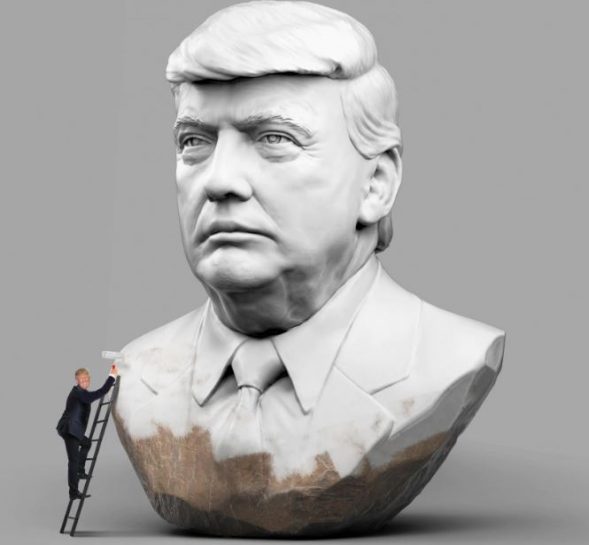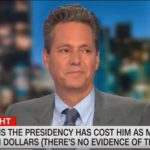June 14, 2019 14 min to read
WaPo Expose: How Trump silenced the people who could expose his business failures
Publication : Articles, Politics, Trump
This article first appeared in the Washington Post here on June 14, 2019.
How did Donald Trump, a self-serving promoter who lost billions of dollars for his investors, convince the world that he is a financial genius? It wasn’t just by fabricating tales of his success. It was also by bullying and silencing people who could have stopped those deceits — particularly reporters and Wall Street analysts — forcing all but a very few into a conspiracy of silence.
These tactics, which form a core element of his politics, were something I saw him hone firsthand in the 1980s and 1990s as Trump’s company was imploding.
I was the lead real estate wealth estimator for the Forbes 400 list in its early years. Trump called me twice in 1984, posing as his fictional “VP of finance” John Barron and professing the kind of riches that ought to land him on the list, despite failing to document them. So when a New York Times exposé last month showed that Trump had lost $1.1 billion between 1985 and 1994, I looked back at my archives and began calling old colleagues to compare these figures with what Trump was telling journalists three decades ago.
First I turned up three never-before-published letters from Trump to Forbes from 1989, in which he claimed to be worth $3.7 billion. We now know that he reported losses of about $100 million that year and that he was treading near insolvency. Then I started to contact other people who had collided with Trump in those years. Journalists told me how he’d tried to block their reporting on his empire — by making up ethical scandals about them, furnishing fake documents and in one case threatening to expose the private life of a closeted media executive. Wall Street analysts witnessed a campaign of intimidation that began when Trump got one of them fired for (correctly) doubting his casinos’ ability to pay off their debts.
Even while he was suffering tremendous financial setbacks — and precisely because he was suffering those setbacks — these efforts show Trump in the desperate act of spinning a mythology about himself (rich) that would sweep aside the facts (broke). And he did it by imperiling the livelihood of his doubters, silencing them and inducing a chilling effect both in the press and among the class of people who are supposed to protect investors from terrible gambles like Trump’s businesses. If this self-promotion scheme had failed, Trump would never have become a reality-TV-starring symbol of business acumen. He would have skulked off into anonymity or ignominy, just another failed real estate developer and speculator.
Instead, he fooled the world. Although he’d struggle for the rest of his career to get most legitimate banks to extend credit, the gambit basically worked: It turned him, rather than his empire, into the product, enabling decades of tabloid coverage, countless eponymous goods from casinos to steaks to airlines, dozens of film and TV cameos, and ultimately his image-defining show, “The Apprentice.” It made a man with limited business savvy and less money than he claimed into someone famous for having a surfeit of both. These early (and shockingly impudent) fabrications built one of the greatest brands in American history — one that made Trump a household name and, eventually, president.
In mid-1989, as his real estate empire was secretly drowning in debt, Trump wrote three letters to Forbes Senior Editor Harold Seneker, who was responsible for overseeing the wealth list. The first, dated April 25, 1989, came with two deceptive documents: One was similar to the outrageously inflated listing of the value of his assets that Trump gave to Deutsche Bank as he sought a loan in 2014 to buy the NFL’s Buffalo Bills. The 1989 file noted that the sums listed were “NET OF MORTGAGES OR DEBT,” and it showed $3,734,000,000 for the total value of Trump’s empire. This figure included “cash and cash equivalents” of $693 million and marketable securities of $214 million.
The other attachment was a “review of the statement of financial condition” letter from Richard L. Robbins, an accountant and senior vice president at accounting firm Arthur Andersen & Co., dated April 10, 1989, attesting to the fact that, as of Nov. 30, 1988, Trump possessed $700,125,000 in “cash and cash equivalents, marketable securities . . . and the remaining cash proceeds from bond issuance and capital contributions.” In his signed letter accompanying these documents, Trump summed it up by writing: “I know that you would be the first to agree that anyone with in excess of $849 million in cash ($700 million plus $149 after paying off the St. Moritz mortgage) is not a person who is ‘highly leveraged.’ Additionally, being a student of financial history, I have relatively low amounts of financing on my assets and, more importantly, personally guarantee nothing.” Robbins declined to comment for this article.
Why was the Arthur Andersen “review” done five months before its Trump account executive sent the letter? Because, unbeknownst to Forbes, just eight days before Nov. 30, 1988, Trump received$675 million in cash proceeds from a junk bond that Merrill Lynch sold to unlucky investors, with all of the funds earmarked for acquiring and completing the Taj Mahal casino in Atlantic City. Trump shouldn’t have claimed this as his own cash, as he appeared to be doing. But that’s what he told Forbes, and anyone else who would listen.
Still, Seneker suspected that Trump’s cash position was overstated, so he wrote back, asking why Trump had listed only assets and not debts. Trump replied the next month with more lies. “My cash balances are high because I am fiscally conservative. The debt which I have is against individual assets and is not personally guaranteed.” He was claiming that the properties themselves and the Trump Organization were the collateral backing up his assets — that he had no personal liability. In truth, Trump was on the hook for $125 million at the Plaza Hotel in Manhattan, according to “Trump Revealed,” an investigative biography by Michael Kranish and Marc Fisher of The Washington Post. This was part of a package of personal guarantees totaling $900 million that would come crashing down around him as his Atlantic City projects imploded.
Knowing that the final estimates for the Forbes 400 list of America’s richest people were calculated in August, Trump sent a third letter in July 1989 bragging that the Plaza was worth double what he paid for it and that his Atlantic City casinos were worth more than $1.5 billion each. Forbes had spent several years radically overstating the value of Trump’s holdings, as recent reporting has shown; the magazine accepted too many of the mogul’s claims. That year, Forbes estimated his worth as $1.7 billion, even though Trump’s leaked tax returns show a $100 million loss, meaning any investor who could have seen them would have viewed Trump’s real estate empire as a money-losing liability, not a group of income-producing assets. (Trump now says these losses reflected depreciation, not the value of his holdings.)
The next year, 1990, would prove to be the year the facade collapsed. But with an eye toward salvaging his future reputation, Trump waged a startlingly effective campaign to suppress the truth about his failures as a businessman. That effort took several forms.
That spring, Forbes Senior Editor Richard Stern and contributor John Connolly prepared a cover story based on a document leaked from the New Jersey Casino Control Commission, which showed the debt load of all of Trump’s properties, as well as a Wall Street analyst’s calculation that the Taj Mahal needed to net $1.3 million every day just to stay afloat. The reporters estimated that Trump’s true net worth figure was less than zero.
On the Monday of the week the story was to be published, Stern met with Trump to seek a comment he could include in the article. The mogul exploded, threatening to sue Forbes. On Tuesday, “orders came from on high” to change the story’s estimate of Trump’s net worth to $500 million, Stern recalls. “I got into a shouting match with [Jim] Michaels,” Forbes’s powerful top editor, Stern says. “Forbes bent. We had to jigger the numbers to give Trump a positive net worth.” (Michaels died in 2007.) Connolly says the cover line was also changed, from “Is Trump Broke?” to “How Much Is Donald Really Worth Now?,” which is how it appeared on May 14, 1990.
Michaels told Connolly this was because Trump was threatening to embarrass the Forbes family by claiming that publisher Malcolm Forbes, who had died a few months earlier, ordered a hit piece because Trump had supposedly blocked the 70-year-old magazine owner from bringing two male companions under the legal drinking age into the Plaza Hotel bar. (A gay news magazine had outed Malcolm Forbes shortly after his death that February, though the claim was not widely circulated; Trump possessed a much louder megaphone with which to humiliate the Forbes family.) Stern does not recall this and believes that editors simply feared a Trump lawsuit.
Even then, Trump was not satisfied with his victory. Connolly and Stern’s story interrupted the mogul’s narrative around the opening of the world’s largest casino. Trump retaliated by making last-minute changes to the text of his August 1990 book, “Surviving at the Top,” to recount the alleged bar spat and say that Malcolm Forbes “lived openly as a homosexual . . . but expected the media and his famous friends to cover for him.” After editors removed him from the annual Forbes 400 in late September (estimating that his net worth by that time had fallen below the $260 million cut-off), Trump elaborated on his accusation in a Los Angeles Times op-ed headlined “Forbes Carried Out Personal Vendetta in Print.” Trump wrote that, after the supposed bar incident, Malcolm Forbes “called and screamed at me, saying that I’d treated him shabbily, embarrassed him publicly — and that he would get even with me,” Trump wrote. “It was only a few weeks later that I got word that Forbes magazine was planning a cover story on me.”
“Nonsense,” Stern says. “Malcolm was dead and buried when we started the article, and I never even talked to Steve” Forbes, the heir who was then running the company. (It also makes no sense for a man who’d kept his private life a secret for decades to bring underage paramours into the Plaza Hotel bar, then kick up a fuss about it with a volatile media hound like Trump.)
Besides neutralizing media reports that would have imperiled his brand as a business genius, Trump also set his sights on a tough-minded documentary directed by Ned Schnurman called “Trump: What’s the Deal?” Schnurman had hired me to report on Trump’s net worth, which is when I learned that he had lied to Forbes for seven years about the number of apartments his family really owned, and when I obtained the three letters Trump sent the magazine. In a September 1989 New York magazine cover story that detailed Trump’s efforts to stop the harshly critical documentary, Schnurman, who is now deceased, said Trump was “threatening litigation before, during, and after the airing of the program.” He believed that Trump pressured TV syndicator LBS Communications to withdraw from its agreement to sell the film, and he told the New York Times that the syndication effort failed because Trump “made an enormous effort to kill the program.” LBS went out of business two years later.
Other broadcasters were too intimidated by Trump to touch the project, according to reporting in New York magazine, and it was not released to the public until it became available online in 2015.
Trump had blocked a broadcast that would have endangered his long-term reputation. (He denied that he had anything to do with stopping Schnurman’s project, telling the New York Times, “I really don’t know what they were trying to prove.”)
Elsewhere, Trump’s bullying was even more brazen — and the consequences even more dire. In March 1990, Marvin Roffman, one of the nation’s leading casino industry stock analysts, told Wall Street Journal reporter Neil Barsky that Trump might not be able to gross the $1.3 million per day he needed to keep the Taj Mahal going. Trump retaliated. He called Roffman’s boss at Janney Montgomery Scott and threatened to sue unless the firm fired Roffman or printed a letter from him saying, in Roffman’s telling, “that sonofabitch reporter Barsky misquoted” him and that “the Taj Mahal was going to be the greatest success ever.” Roffman, a 17-year veteran analyst, resisted and was fired the next day. The following year, not long before the Taj went belly up, Roffman won a $750,0000 arbitration decision against his former firm. Soon after that, he settled a defamation suit, for an undisclosed sum, against Trump.
Still, the firing didn’t go unnoticed on Wall Street, and other observers began to moderate what they told investors about Trump’s stocks and bonds, even though they were clearly terrible investments. “We have had a number of calls from analysts around the country who are very concerned about this,” Alfred Morley, president of the national organization representing financial analysts, told the New York Times at the time. “Their basic concern is, Is the analyst’s responsibility in jeopardy because of an outside influence?”
Trump had laid the groundwork perfectly for his comeback a few years later. In 1995 and 1996, he floated more than $500 million in public stock offerings and more than $1.3 billion in junk bonds to Trump Hotels and Casino Resorts, his consolidated holdings company. One might think that after the 1991 bankruptcy, which caused lenders to lose billions of dollars, analysts would warn their clients against buying Trump’s stock or junk bonds. Yet in searching news reports from those years, I could not find a single Wall Street analyst who told the media anything negative about Trump’s new public company. Trump’s finances were a mess: His Taj Mahal casino had lost more than $136 million during the four previous years, and he was just weeks from defaulting on his own loans when the stock debuted in 1995. But Wall Street was careful not to criticize. “After I got fired, analysts weren’t able to speak freely,” Roffman recalls. It “sent a message to others in our business. . . . ‘Keep your mouth shut or you’ll never work in this industry again.’ After that I could not get a job as an analyst.” He sums up that period this way: “Telling the truth about Trump was dangerous to your career.” It was also a perilous time for investors, who, over the next 14 years, would lose more than $1.5 billion on Trump’s stocks and bonds as the public casino company went bankrupt twice.
Trump found a way to send a similar message to reporters, like Barsky, the Wall Street Journal correspondent who had recently won a prestigious award for covering the collapse of Trump’s empire. As Barsky recalled in a 2016 op-ed, a Trump executive called in 1991 and invited him to a boxing match in Atlantic City. “I declined at first, but my editor encouraged me to go,” Barsky wrote. “Then, in an act of bad judgment, I accepted free tickets for my brother and father.” A few weeks later, Barsky wrote a tough piece about Trump’s finances, after which, as he recounted in his op-ed, a Trump spokesman called the New York Post and, according to a senior Post reporter, asked, “How would you like to destroy the career of a Wall Street Journal reporter?” The spokesman told the Post that Barsky had “extorted the tickets, asked for a suite at the Taj, and that out of anger that I hadn’t received more favors, had written negative articles” about Trump. The Post ran a piece airing the claims.
To prevent the appearance of a conflict of interest, the Journal reassigned Barsky in June 1991 to a beat where he wouldn’t be covering Trump. The businessman had removed one of his most accomplished chroniclers, someone who had carefully, over years, developed the skills to understand the mogul’s universe and undermine his public image. Trump has a “magical, superhuman ability to rewrite his own history,” Barsky said in his first interview about Trump in years. “He is the best salesman of his own myth that anyone has ever seen; the myth was that he was a winner.”
Trump had waged a relentless, vindictive campaign to build his own myth by suppressing the facts: Between the collapse of his empire in 1991 and the issuance of more than $1 billion in Trump Hotels and Casino Resorts stock and junk bonds by 1996, he’d compromised the truth-telling capacity of Forbes magazine, the Wall Street Journal, TV broadcasters, Arthur Andersen and casino analysts on Wall Street. By the time Trump resigned in 2009 as chairman of the public company he founded, he had paid himself an estimated $82 million in personal compensation, while the company’s stocks and bonds had become nearly worthless.
His brand survived all that, and even thrived, because he wasn’t just concocting tales of his greatness; he was also forcing others to repeat them, or at least not to contradict them. It was a strategy that more recently has paid off handsomely against onetime opponents like Sen. Lindsey Graham. Nobody can succeed on this scale simply by lying. Trump’s greatest and most cynical skill, honed during the 1980s and 1990s, was learning how to win by silencing truth-tellers and suppressing the truth when it matters most.





Comments (1)
-

REV. VINCENT TURNER June 22, 2019
This bust of Donald Trump portrays Trump precisely as he sees himself: Romanesque and Caesar like in stature and statue. It has the aura of Stalin, Mussolini and Lenin about it. I suspect if Trump sees this he will become totally orgasmic. Such a pristine tribute to such a monstrous human being is out of place and sends a message to sycophants who have turned Trump into an idol. The last thing Trump needs is more adulation. An image of Satan would be more appropriate.